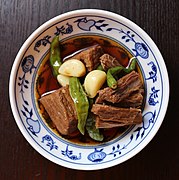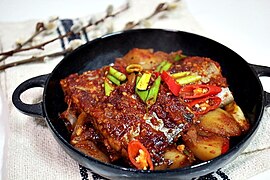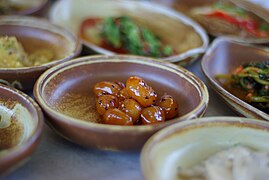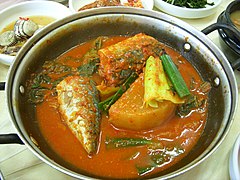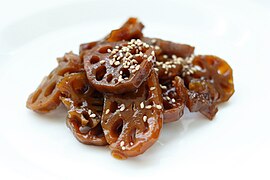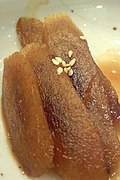Jorim: Difference between revisions
copy edit |
RodRabelo7 (talk | contribs) m deprecated |
||
| (23 intermediate revisions by 17 users not shown) | |||
| Line 1: | Line 1: | ||
{{Short description|Korean simmered dish}} |
|||
{{Copy edit|date=May 2017}} |
|||
{{Infobox food |
{{Italic title}}{{Infobox food |
||
| name = ''Jorim'' |
| name = ''Jorim'' |
||
| image = Godeungeo-jorim.jpg |
| image = Godeungeo-jorim.jpg |
||
| Line 33: | Line 33: | ||
| rr = jorim |
| rr = jorim |
||
| mr = chorim |
| mr = chorim |
||
| koreanipa = {{IPA |
| koreanipa = {{IPA|ko|tɕo.ɾim|}} |
||
}} |
}} |
||
{{Korean cuisine}} |
{{Korean cuisine}} |
||
'''''Jorim''''' ({{Korean|hangul=조림 |
'''''Jorim''''' ({{Korean|hangul=조림}}) is a category of dishes in [[Korean cuisine]], made by simmering [[vegetable]]s, [[meat]], [[fish as food|fish]], [[seafood]], or [[tofu]] in seasoned [[broth]] until the liquid is absorbed into the ingredients and reduced down. ''Jorim'' dishes are usually [[soy sauce]]-based, but [[gochujang]] (고추장) or [[gochugaru]] (고춧가루) can also be added, especially when fishier, red-fleshed fish such as [[chub mackerel|mackerel]], [[Pacific saury|saury]], or [[largehead hairtail|hairtail]] are used.<ref name="EKC">{{Cite web|url=http://encykorea.aks.ac.kr/Contents/Index?contents_id=E0051727|title=jorim|last=이|first=효지|website=[[Encyclopedia of Korean Culture]]|publisher=[[Academy of Korean Studies]]|language=ko|script-title=ko:조림|access-date=1 May 2017}}</ref> In [[Korean royal court cuisine]], ''jorim'' is called '''''jorini''''' ({{lang|ko|조리니}}).<ref name="Doo">{{Cite web|url=http://www.doopedia.co.kr/doopedia/master/master.do?_method=view&MAS_IDX=101013000859000|title=jorim|website=[[Doopedia]]|publisher=[[Doosan Corporation]]|language=ko|script-title=ko:조림|access-date=1 May 2017}}</ref> |
||
== Etymology == |
== Etymology == |
||
''Jorim'' is a verbal noun derived from Korean verb ''jorida'' ({{lang|ko|조리다}}; "to boil down").<ref name="KELD">{{Cite web|url=https://krdict.korean.go.kr/eng/dicSearch/SearchView?nation=eng&ParaWordNo=75435|title=jorim|website=[[ |
''Jorim'' is a verbal noun derived from the Korean verb ''jorida'' ({{lang|ko|조리다}}; "to boil down").<ref name="KELD">{{Cite web|url=https://krdict.korean.go.kr/eng/dicSearch/SearchView?nation=eng&ParaWordNo=75435|title=jorim|website=[[Korean–English Learners' Dictionary]]|publisher=[[National Institute of Korean Language]]|script-title=ko:조림|access-date=1 May 2017}}</ref><ref name="KELD2">{{Cite web|url=https://krdict.korean.go.kr/eng/dicSearch/SearchView?nation=eng&ParaWordNo=75503|title=jorida|website=[[Korean–English Learners' Dictionary]]|publisher=[[National Institute of Korean Language]]|script-title=ko:조리다|access-date=1 May 2017}}</ref> Although it was a commonly used culinary technique, the term did not appear until the 18th century, due to the slow development of culinary terminology.<ref name="EKC" /> Instead, ''jorim'' dishes were classified as ''jochi'', a category that encompasses ''[[jjim]]'' and ''[[jjigae]]'' as well as ''jorim''.<ref name="Doo" /><ref name="SKLD">{{Cite web|url=http://stdweb2.korean.go.kr/search/View.jsp?idx=298809|title=jochi|website=[[Standard Korean Language Dictionary]]|publisher=[[National Institute of Korean Language]]|language=ko|script-title=ko:조치|access-date=1 May 2017}}</ref> The first mention of the verbal noun ''jorim'' as a food category appeared in ''[[Siuijeonseo]]'', a 19th-century cookbook, in describing ''jang-jorim'' (soy sauce simmered beef) methods.<ref name="EKC" /> |
||
== Varieties == |
== Varieties == |
||
* ''dubu-jorim'' ({{lang|ko|두부조림}}) – simmered [[tofu]]<ref name="Ro">{{Cite news|url=http://www.straitstimes.com/lifestyle/food/a-recipe-for-dubu-jorim-a-spicy-korean-braised-tofu|title=A recipe for dubu jorim, a spicy Korean braised tofu|last=Ro|first=Hyo-sun|date=19 April 2017|work=[[The Straits Times]]|access-date=1 May 2017}}</ref> |
* ''dubu-jorim'' ({{lang|ko|두부조림}}) – simmered [[tofu]]<ref name="Ro">{{Cite news|url=http://www.straitstimes.com/lifestyle/food/a-recipe-for-dubu-jorim-a-spicy-korean-braised-tofu|title=A recipe for dubu jorim, a spicy Korean braised tofu|last=Ro|first=Hyo-sun|date=19 April 2017|work=[[The Straits Times]]|access-date=1 May 2017}}</ref> |
||
* ''galchi-jorim |
* {{Ill|Galchi-jorim|lt=''galchi-jorim|ko|갈치조림}} ({{lang|ko|갈치조림}}) – simmered [[Trichiurus lepturus|largehead hairtail]] |
||
* ''gamja-jorim'' ({{lang|ko|감자조림}}) – simmered [[potato]]es<ref name="Anderson">{{Cite news|url=http://www.sandiegoreader.com/news/2014/oct/25/feast-side-dishes-order-anything/|title=Side dishes with an order of anything|last=Anderson|first=Ian|date=25 October 2014|work=[[San Diego Reader]]|access-date=1 May 2017}}</ref> |
* ''gamja-jorim'' ({{lang|ko|감자조림}}) – simmered [[potato]]es<ref name="Anderson">{{Cite news|url=http://www.sandiegoreader.com/news/2014/oct/25/feast-side-dishes-order-anything/|title=Side dishes with an order of anything|last=Anderson|first=Ian|date=25 October 2014|work=[[San Diego Reader]]|access-date=1 May 2017}}</ref> |
||
* ''godeungeo-jorim'' ({{lang|ko|고등어조림}}) – simmered [[Scomber japonicus|chub mackerel]] and [[Korean radish|radish]]<ref name="Zappia">{{Cite news|url=http://www.thestranger.com/food-and-drink/2016/10/26/24645304/mackerel-you-sexy-bastard|title=Mackerel, You Sexy Bastard|last=Zappia|first=Corina|date=26 October 2016|work=[[The Stranger (newspaper)|The Stranger]]|access-date=1 May 2017}}</ref> |
* ''godeungeo-jorim'' ({{lang|ko|고등어조림}}) – simmered [[Scomber japonicus|chub mackerel]] and [[Korean radish|radish]]<ref name="Zappia">{{Cite news|url=http://www.thestranger.com/food-and-drink/2016/10/26/24645304/mackerel-you-sexy-bastard|title=Mackerel, You Sexy Bastard|last=Zappia|first=Corina|date=26 October 2016|work=[[The Stranger (newspaper)|The Stranger]]|access-date=1 May 2017}}</ref> |
||
* |
* [[Jang-jorim]] ({{lang|ko|장조림}}) – simmered [[soy sauce]] simmered [[beef]] |
||
* ''kkaennip-jorim'' ({{lang|ko|깻잎조림}}) – simmered [[kkaennip|perilla leaves]] |
* ''kkaennip-jorim'' ({{lang|ko|깻잎조림}}) – simmered [[kkaennip|perilla leaves]] |
||
* ''kkongchi-jorim'' ({{lang|ko|꽁치조림}}) – simmered [[Pacific saury|saury]] |
|||
* ''ueong-jorim'' ({{lang|ko|우엉조림}}) – simmered [[Arctium lappa|burdock]] roots |
* ''ueong-jorim'' ({{lang|ko|우엉조림}}) – simmered [[Arctium lappa|burdock]] roots |
||
* ''yeongeun-jorim'' ({{lang|ko|연근조림}}) – simmered [[Nelumbo nucifera|lotus]] roots |
* ''yeongeun-jorim'' ({{lang|ko|연근조림}}) – simmered [[Nelumbo nucifera|lotus]] roots |
||
== Gallery == |
== Gallery == |
||
<gallery> |
<gallery mode=packed> |
||
Jangjorim.jpg|''Jang-jorim'' (soy sauce simmered beef) |
Jangjorim.jpg|''Jang-jorim'' (soy sauce simmered beef) |
||
Galchi-jorim.jpg|''Galchi-jorim'' (simmered hairtail) |
Galchi-jorim.jpg|''Galchi-jorim'' (simmered hairtail) |
||
| Line 65: | Line 66: | ||
== See also == |
== See also == |
||
{{Commons}} |
{{Commons}} |
||
* [[Braising]] |
|||
* ''[[Jjim]]'' |
* ''[[Jjim]]'' |
||
* ''[[Kho (cooking technique)|Kho]]'' |
|||
== References == |
== References == |
||
Latest revision as of 15:53, 11 August 2024
 Godeungeo-jorim (simmered chub mackerel) | |
| Place of origin | Korea |
|---|---|
| Associated cuisine | Korean cuisine |
| Similar dishes | Nimono |
| Korean name | |
| Hangul | 조림 |
|---|---|
| Revised Romanization | jorim |
| McCune–Reischauer | chorim |
| IPA | [tɕo.ɾim] |
 |
| This article is part of a series on |
| Korean cuisine 한국 요리 조선 료리 |
|---|
Jorim (Korean: 조림) is a category of dishes in Korean cuisine, made by simmering vegetables, meat, fish, seafood, or tofu in seasoned broth until the liquid is absorbed into the ingredients and reduced down. Jorim dishes are usually soy sauce-based, but gochujang (고추장) or gochugaru (고춧가루) can also be added, especially when fishier, red-fleshed fish such as mackerel, saury, or hairtail are used.[1] In Korean royal court cuisine, jorim is called jorini (조리니).[2]
Etymology
[edit]Jorim is a verbal noun derived from the Korean verb jorida (조리다; "to boil down").[3][4] Although it was a commonly used culinary technique, the term did not appear until the 18th century, due to the slow development of culinary terminology.[1] Instead, jorim dishes were classified as jochi, a category that encompasses jjim and jjigae as well as jorim.[2][5] The first mention of the verbal noun jorim as a food category appeared in Siuijeonseo, a 19th-century cookbook, in describing jang-jorim (soy sauce simmered beef) methods.[1]
Varieties
[edit]- dubu-jorim (두부조림) – simmered tofu[6]
- galchi-jorim (갈치조림) – simmered largehead hairtail
- gamja-jorim (감자조림) – simmered potatoes[7]
- godeungeo-jorim (고등어조림) – simmered chub mackerel and radish[8]
- Jang-jorim (장조림) – simmered soy sauce simmered beef
- kkaennip-jorim (깻잎조림) – simmered perilla leaves
- kkongchi-jorim (꽁치조림) – simmered saury
- ueong-jorim (우엉조림) – simmered burdock roots
- yeongeun-jorim (연근조림) – simmered lotus roots
Gallery
[edit]-
Jang-jorim (soy sauce simmered beef)
-
Galchi-jorim (simmered hairtail)
-
Dubu-jorim (simmered tofu)
-
Gamja-jorim (simmered potatoes)
-
Godeungeo-jorim (simmered mackerel)
-
Gyeran-jang-jorim (soy sauce simmered eggs)
-
Yeongeun-jorim (simmered lotus roots)
-
Ueong-jorim (simmered burdock roots)
See also
[edit]References
[edit]- ^ a b c 이, 효지. "jorim" 조림. Encyclopedia of Korean Culture (in Korean). Academy of Korean Studies. Retrieved 1 May 2017.
- ^ a b "jorim" 조림. Doopedia (in Korean). Doosan Corporation. Retrieved 1 May 2017.
- ^ "jorim" 조림. Korean–English Learners' Dictionary. National Institute of Korean Language. Retrieved 1 May 2017.
- ^ "jorida" 조리다. Korean–English Learners' Dictionary. National Institute of Korean Language. Retrieved 1 May 2017.
- ^ "jochi" 조치. Standard Korean Language Dictionary (in Korean). National Institute of Korean Language. Retrieved 1 May 2017.
- ^ Ro, Hyo-sun (19 April 2017). "A recipe for dubu jorim, a spicy Korean braised tofu". The Straits Times. Retrieved 1 May 2017.
- ^ Anderson, Ian (25 October 2014). "Side dishes with an order of anything". San Diego Reader. Retrieved 1 May 2017.
- ^ Zappia, Corina (26 October 2016). "Mackerel, You Sexy Bastard". The Stranger. Retrieved 1 May 2017.
